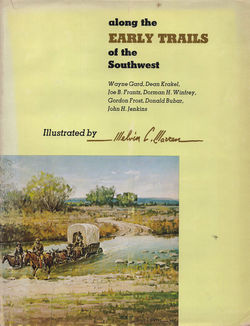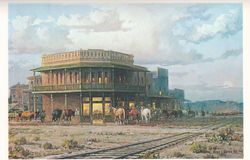ALONG
THE EARLY TRAILS OF THE SOUTHWEST HBDJ DODGE CITY SANTA FE CHISHOLM SAN ANTONIO
HARDBOUND BOOK with DUSTJACKET
in ENGLISH by WAYNE GARD, DEAN KRAKEL, JOE B. FRANTZ, DORMAN H. WINFREY, GORDON
FROST, DONALD BUBAR and JOHN H. JENKINS.
ILLUSTRATED BY MELVIN C. WARREN,
Western Artist
THE PEMBERTON PRESS (First
Edition, 1969)
BUTTERFIELD OVERLAND MAIL TRAIL
- stagecoach service in the United States operating from 1858 to 1861. It
carried passengers and U.S. Mail from two eastern termini, Memphis, Tennessee,
and St. Louis, Missouri, to San Francisco, California. The routes from each
eastern terminus met at Fort Smith, Arkansas, and then continued through Indian
Territory (Oklahoma), Texas, New Mexico, Arizona, Mexico, and California ending
in San Francisco.[2] On March 3, 1857, Congress authorized the U.S. postmaster
general, at that time Aaron V. Brown, to contract for delivery of the U.S. mail
from St. Louis to San Francisco. Prior to this, U.S. Mail bound for the Far
West had been delivered by the San Antonio and San Diego Mail Line (Jackass
Mail) since June 1857.
OLD SAN ANTONIO ROAD - a historic roadway
located in the U.S. states of Texas and Louisiana. Parts of it were based on
traditional Native American trails. Its Texas terminus was about 35 miles (56
km) southeast of Eagle Pass at the Rio Grande in Maverick County, and its
northern terminus was at Natchitoches, Louisiana. The road continued from Texas
through Monclova to Mexico City.
CHISHOLM TRAIL - a trail used in
the post-Civil War era to drive cattle overland from ranches in Texas to Kansas
railheads. The trail was established by Black Beaver, a Lenape guide and
rancher, and his friend Jesse Chisholm, a Cherokee merchant. They collected and
drove numerous cattle along the trail to Kansas, where they could be shipped
east to achieve higher prices. The southern terminus was Red River Station, a
trading post near the Red River along the northern border of Texas. The
northern terminus was a trading post near Kansas City, Kansas. Chisholm owned
both of these posts. In the years of the cattle drives, cowboys drove large
herds from ranches across Texas to the Red River Station and then north to
Kansas City.
SANTA FE TRAIL - a 19th-century
route through central North America that connected Franklin, Missouri, with
Santa Fe, New Mexico. Pioneered in 1821 by William Becknell, who departed from
the Boonslick region along the Missouri River, the trail served as a vital
commercial highway until 1880, when the railroad arrived in Santa Fe. Santa Fe
was near the end of El Camino Real de Tierra Adentro which carried trade from
Mexico City. The trail was later incorporated into parts of the National Old Trails
Road and U.S. Route 66. The route skirted the northern edge and crossed the
north-western corner of Comancheria, the territory of the Comanche. Realizing
the value, they demanded compensation for granting passage to the trail.
American traders envisioned them as another market. Comanche raiding farther
south in Mexico isolated New Mexico, making it more dependent on the American
trade. They raided to gain a steady supply of horses to sell. By the 1840s,
trail traffic through the Arkansas Valley was so numerous that bison herds were
cut off from important seasonal grazing land. This habitat disruption, on top
of overhunting, contributed to the collapse of the species. Comanche power
declined in the region when they lost their most important game. In 1846, during the Mexican–American War, the
United States Army used the Santa Fe Trail to invade New Mexico. After the U.S. acquisition of the Southwest
that ended the war, the trail was integral to the U.S. opening the region to
economic development and settlement. It played a vital role in the westward
expansion of the U.S. into these new lands.
DODGE CITY TRAIL - The Great
Western Cattle Trail was used during the late 19th century for movement of
cattle and horses to markets in eastern and northern states. It is also known
as the Western Trail, Fort Griffin Trail, Dodge City Trail, Northern Trail and
Texas Trail. It replaced the Chisholm trail when that closed. While it wasn't
as well known, it was greater in length, reaching railheads up in Kansas and
Nebraska and carried longhorns and horses to stock open-range ranches in the
Dakotas, Wyoming, Montana, and two provinces in Canada. It took almost one
hundred days to reach their destination.
The Great Western Trail ran south of and roughly parallel to the Chisholm
Trail into Kansas. The cattle were taken to towns located on major railroads
and delivered north to establish ranches. Although rail lines were built in
Texas, the cattle drives north continued because Texas rail prices made it more
profitable to trail them north.
GOODNIGHT-LOVING TRAIL - a trail
used in the cattle drives of the late 1860s for the large-scale movement of
Texas Longhorns. It is named after cattlemen Charles Goodnight and Oliver
Loving. The Goodnight-Loving Trail began at Fort Belknap (Texas), along part of
the former route of the Butterfield Overland Mail, traveling through Central
Texas across the Llano Estacado (Staked Plains) to Horsehead Crossing, north
along the Pecos River and across Pope's Crossing, into New Mexico to Fort Sumner.
The trail then continued north into Colorado to Denver and was extended on into
Wyoming. In June 1866, Charles Goodnight
and Oliver Loving decided to partner to drive cattle to growing western
markets. They hoped that demand for beef from settlers, soldiers stationed at
military outposts across New Mexico, and Navajos recently placed on
reservations near Fort Sumner would make the drive profitable.[2] With 18
cowpunchers, they brought 2,000 head of cattle to Fort Sumner, New Mexico. Over
8,000 Navajo had been interned at the Bosque Redondo reservation under the
control of the fort, but due to the poor conditions on the reservation for
agriculture and inadequate planning by the US authorities for provisions, the
demand for new food supplies became urgent. Goodnight and Loving received
$0.08/pound for the steers in the herd, although they were unable to interest
the government agent in 800 stocker cattle. Goodnight returned to Texas with
about $12,000 in gold to buy more cattle.
Loving continued north towards the railhead in Denver, with the
remaining cattle and calves. He was stopped by a tollgate chain in the Raton
Pass, operated by Richens Lacey Wootton. Loving paid Wootton 10 cents per head
of cattle. In Denver, Loving sold the herd to John Wesley Iliff.
TRAIL BRANDING ON THE KING RANCH
BACK DOWN THE TRAIL TO TEXAS







